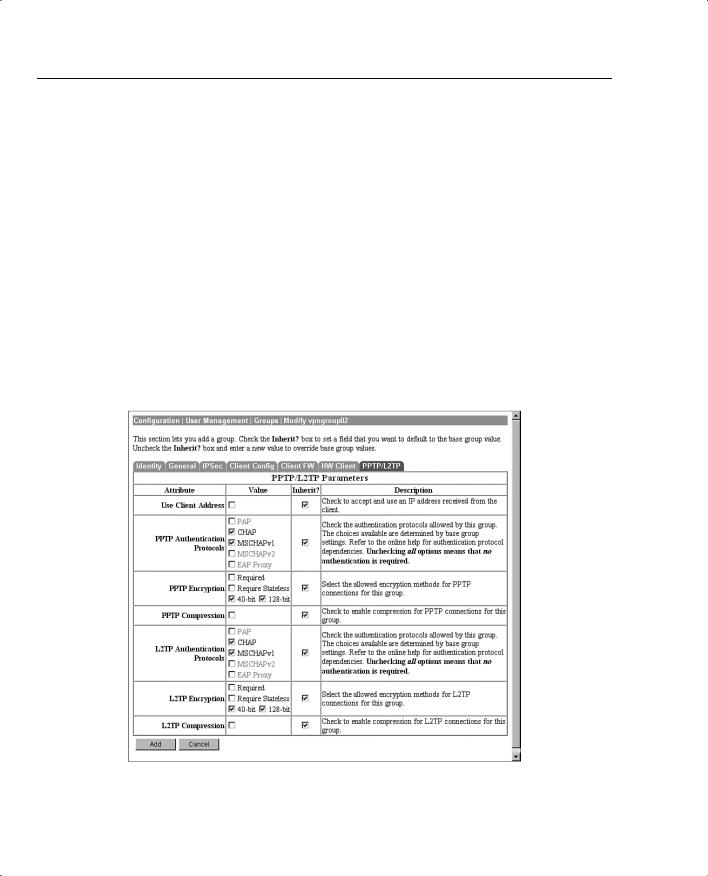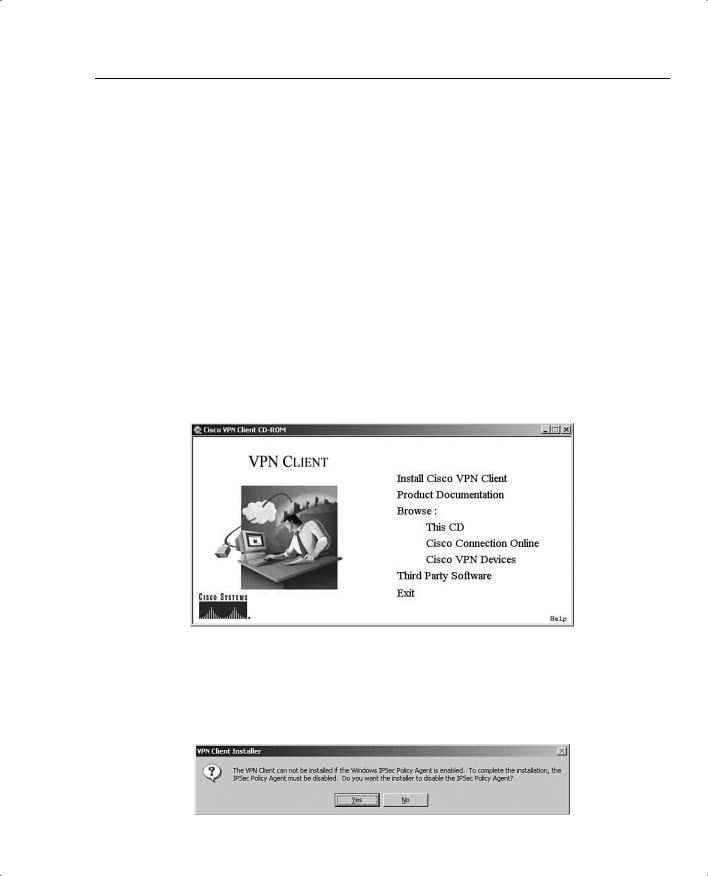
Cisco Secure VPN Exam Certification Guide - Cisco press
.pdf
168Chapter 4: Configuring Cisco VPN 3000 for Remote Access Using Preshared Keys
—40-bit—Clients can use the RSA RC4 encryption algorithm using a 40-bit key when this option is checked.
—128-bit—Clients can use the RSA RC4 encryption algorithm using a 128-bit key when this option is checked.
•PPTP Compression—If many of your clients connect via dial-up connections, you might want to enable PPTP compression to decrease the amount of data being transferred. If you enable compression, the Microsoft Point-to-Point Compression (MPPC) algorithm is used.
•L2TP Authentication Protocols—L2TP authentication protocol options are the same as the PPTP options previously discussed.
•L2TP Encryption—L2TP encryption options are the same as the PPTP options previously discussed.
•L2TP Compression—L2TP compression options are the same as the PPTP options previously discussed.
Figure 4-26 Configuration | User Management | Groups | Modify > PPTP/L2TP

VPN Concentrator Configuration 169
Advanced Configuration of the VPN Concentrator
The previous sections of this chapter looked at a small part of the Configuration portion of the VPN Manager. There is much more to the Manager than installing groups, users, or system identification. This section looks at the other aspects of the Configuration portion of the VPN Manager.
Configuration | System
The functions that fall under the Configuration | System section have to do with configuring parameters for system-wide functions in the VPN concentrator. The following subcategories under System let you control the VPN concentrator:
•
•
•
•
•
•
•
•
•
•
•
Configuration | System | Servers Configuration | System | Address Management Configuration | System | Tunneling Protocols Configuration | System | IP Routing
Configuration | System | Management Protocols Configuration | System | Events
Configuration | System | General
Configuration | System | Client Update
Configuration | System | Load Balancing Cisco VPN Clients Configuration | User Management
Configuration | Policy Management
The following sections describe each subcategory in more detail.
Configuration | System | Servers
The Configuration | System | Servers section of the VPN Manager allows you to configure the various types of servers that communicate with the concentrator. Those servers include the following:
•Authentication Servers—Used for user authentication
•Accounting Servers—Used for RADIUS user accounting
•DNS Servers—Domain Name System address lookup functions
•DHCP Servers—Dynamic Host Configuration Protocol to assign IP addresses for client connections
•Firewall Servers—Firewall enforcement by means of the Zone Labs Integrity Server

170Chapter 4: Configuring Cisco VPN 3000 for Remote Access Using Preshared Keys
•NTP Servers—Network Time Protocol to ensure that all systems use the same time for ease of synchronizing log entries
•Internal Authentication—Used for user authentication
Configuration | System | Address Management
When an IPSec tunnel is established between a VPN concentrator and client, a new set of IP addresses is required to identify the endpoints of the tunnel. This section of the VPN Manager allows you to define how these addresses are managed.
The Assignment portion of Address Management allows you to select the methods that can be used to assign addresses. Quick Configuration used this portion as part of its setup steps.
The Pools portion of Address Management allows you to define a pool of internal addresses that the concentrator draws from when assigning addresses to clients.
Configuration | System | Tunneling Protocols
Cisco VPN 3000 Concentrators are capable of establishing tunnels using the three most popular VPN tunneling protocols:
•
•
•
PPTP
L2TP
IPSec
To provide support for the Microsoft Windows 2000 VPN client, the VPN concentrators also support L2TP over IPSec.
This section of the VPN Manager allows you to configure the parameters that are associated with each of these protocols.
Configuration | System | IP Routing
Cisco VPN 3000 Concentrators have the ability to act as routers for IP traffic. This allows the concentrator to communicate with other routers in the network to determine the best path for traffic to take. This section of the VPN Manager allows you to configure the following:
•Static Routes—Manually configured routing tables
•Default Gateways—Routes for traffic for which routes cannot be determined
•OSPF—Open Shortest Path First routing protocol
•OSPF Areas—Subnet areas within the OSPF domain
•DHCP—Dynamic Host Configuration Protocol global parameters

VPN Concentrator Configuration 171
•Redundancy—Virtual Router Redundancy Protocol parameters
•Reverse Route Injection—Reverse Route Injection global parameters
Routing Information Protocol (RIP) and interface-specific OSPF parameters are configured on the network interfaces. You access the interfaces to make those configurations through the Configuration | Interfaces screen.
Configuration | System | Management Protocols
The Configuration | System | Management Protocols portion of the VPN Manager allows you to control various management protocols and servers. These utilities can be an asset to you in managing your total network. Those management protocols are as follows:
•FTP—File Transfer Protocol
•HTTP/HTTPS—Hypertext Transfer Protocol and HTTP over SSL (Secure Sockets Layer) protocol
•TFTP—Trivial File Transfer Protocol
•Telnet—Terminal emulation protocol and Telnet over SSL
•SNMP—Simple Network Management Protocol
•SNMP Community Strings—Identifiers for valid SNMP clients
•SSL—Secure Sockets Layer Protocol
•SSH—Secure Shell
•XML—Extensible Markup Language
Configuration | System | Events
Significant occurrences within or that could affect a VPN 3000 Concentrator are classified as events. Typical events include alarms, traps, error conditions, network problems, task completions, breaches of threshold levels, and status changes. Events are stored in an event log in nonvolatile memory. Events can also be sent to a backup server via FTP or to Syslog servers. Events can be identified to trigger console messages, send e-mail messages, or send SNMP system traps.
Event attributes include class and severity level, as follows:
•Event Class—Specifies the source of the event and refers to a specific hardware or software subsystem within the VPN concentrator.
•Event Severity Level—Indicates how serious or significant the event is. Level 1 is the most significant.

172 Chapter 4: Configuring Cisco VPN 3000 for Remote Access Using Preshared Keys
Configuration | System | General
The General section of the VPN Manager enables you to configure these general VPN concentrator parameters:
•
•
•
•
Identification—System name, contact person, system location
Time and Date—System time and date
Sessions—The maximum number of sessions
Authentication—General authentication parameters
Configuration | System | Client Update
You can configure the Cisco VPN 3000 Concentrators to manage client updates for VPN Client and VPN 3002 Hardware Clients. In the case of the software clients, the concentrator notifies the clients of the acceptable client versions and provides the location where the appropriate versions can be obtained. For VPN 3002 Hardware Clients, the concentrator pushes the correct version to the client via TFTP.
This section of the VPN 3000 Concentrator Manager lets you configure the client update feature, as follows:
•Enable—Enables or disables client update
•Entries—Configures updates by client type, acceptable firmware and software versions, and their locations
Configuration | System | Load Balancing Cisco VPN Clients
When you have two or more VPN 3000 Concentrators on the same subnet handling remote access VPN services, you can group those devices together to perform load balancing across the devices. The private and public subnets are grouped into a virtual cluster. One of the concentrators acts as the cluster master and directs incoming calls to the device that has the smallest load, including itself. If, for any reason, the master fails, one of the other concentrators in the cluster takes over the role.
Clients first connect to the virtual IP address of the cluster. The cluster master intercepts the call and sends the client the public IP address of the least-loaded available concentrator. The client then uses that IP address to initiate the VPN tunnel with the concentrator. If a concentrator in the cluster fails, the terminated clients immediately try to reconnect with the virtual IP, and the cluster master reassigns them to available devices.
After you have made certain that the public and private interfaces have been fully configured and are operational, you use this section of the VPN 3000 Concentrator Manager to define the load-sharing cluster.

VPN Concentrator Configuration 173
Configuration | User Management
Configuration | User Management is the section that you used in the “Configuring IPSec with Preshared Keys Through the VPN 3000 Concentrator Series Manager” section of this chapter to configure the group for remote access with preshared keys. In addition to working with specific groups, this section is used to configure the Base Group and to manage user accounts for the internal authentication database.
With the default settings, new groups inherit the attributes of the Base Group. Those attributes can be individually overridden for each group so that you can have a variety of groups with different properties. You could have a group using L2TP, one using IPSec with preshared keys, another using IPSec with digital certificates, another using RADIUS for user authentication, and still another using the concentrator’s internal database for user authentication.
If you are using the concentrator for internal authentication and have defined your groups, this section of the VPN Manager also allows you to create and manage user accounts. User accounts inherit the attributes of their group, and user accounts can only belong to one group. If you do not explicitly assign a user account to a group, it inherits the attributes of the Base Group.
Configuration | Policy Management
Policies control the actions of users as they connect to the VPN concentrator. User management determines which users are allowed to use the device. Policy management determines when users can connect, from where they can connect, and what kind of data are permitted in the tunnels. The section of the VPN Manager established filters that determine whether to forward or drop packets and whether to pass the traffic through a tunnel or to send it in the clear. Filters are applied to interfaces, groups, and users.
The Policy Management section contains the following sections:
•Access Hours—Establishes when remote users can access the VPN concentrator.
•Traffic Management—Controls what data traffic can flow through the VPN concentrator. Traffic Management is further divided into the following configuration sections:
—Network Lists—Allows you to group lists of networks together as single objects.
—Rules—Provides detailed parameters that let you specify the handling of data packets.
—SAs—Lets you choose the options to be used in establishing IPSec Security Associations. This is where you set the authentication, encryption, encapsulation, and SA lifetime. You can modify predefined SAs or create your own.
—Filters—Lets you combine the network lists, rules, and SAs into single packages that you can then apply to interfaces, groups, and users.
—NAT—The Cisco VPN 3000 Concentrators can perform Network Address Translation, which you would configure in this section.

174 Chapter 4: Configuring Cisco VPN 3000 for Remote Access Using Preshared Keys
Installing and Configuring the VPN Client
14 Configuring the IPSec Windows Client
The Cisco VPN Client is packaged with every VPN concentrator sold by Cisco. The VPN Client can be installed on several different operating systems, including Linux, Sun Solaris, Apple MAC OS X, and Microsoft Windows. This section looks at the Microsoft Windows version of the VPN Client.
The following topics are covered in this section:
•
•
•
•
Overview of the VPN Client
VPN Client features
VPN Client installation
VPN Client configuration
Overview of the VPN Client
The Microsoft Windows version of the VPN Client runs on Windows 95, 98, 98 SE, Me, NT, 2000, and XP platforms. The client is designed to work as a remote access client connecting through a secure data tunnel to an enterprise network over the Internet. This permits remote users to access the services of a private network as though the users were attached directly to the network, with the security of encrypted communications between the client and the host.
To use the VPN Client after it has been installed, the user first connects to the Internet and then starts the VPN Client to negotiate a tunnel with the VPN host. For remote access services, that host is most commonly a VPN concentrator, but it could be a router or firewall, or some other network device.
To start the VPN Client from a Windows-based PC, select Start, Programs, Cisco Systems VPN Client, and then select one of the following programs:
•Certificate Manager—Manage digital certificates for the client to be used when authenticating with VPN devices.
•Help—View the complete online manual with full instructions on using the VPN Client application.
•Log Viewer—View events from the log file.
•Set MTU—Control the maximum transmission unit (MTU) size that the VPN Client is to use to communicate with the host.

Installing and Configuring the VPN Client 175
•Uninstall VPN Client—Uninstall the application. You can choose to retain connection and certificate information.
•VPN Dialer—Manage connection information and start a connection with a VPN host device. This poorly named function is the main functional area of the VPN Client.
You can use the VPN Client with dial-up, ISDN, cable, or DSL modems as well as with direct LAN connections. How you get to the Internet does not matter to the VPN Client. The only requirement is that the client device can “see” the host device using TCP/IP.
VPN Client Features
The VPN Client is a feature-packed application. Most of the functions of the client are handled automatically and require little configuration. This section describes the important features of the Cisco VPN Client.
Program features include the following:
•Browser-based, context-sensitive HTML help
•VPN 3000 Series Concentrator support
•Command-line interface to the VPN Dialer application
•Access to local LAN resources while connected through a secure VPN
•Automatic VPN Client configuration option
•Log Viewer application to collect, view, and analyze events
•Ability to set the MTU size
•Application launcher
•Automatic connection via Microsoft Dial-Up Networking and other third-party dialers
•Software update notifications from the connecting VPN device
•Launch software update site from update notification
NT features include the following:
•Password expiration information from RADIUS authentication servers
•Start Before Logon, providing the ability to establish a VPN connection before logging on to a Windows NT platform
•Automatic disconnect disable when logging off to allow for roaming profile synchronization
IPSec features include the following:
•
•
•
IPSec tunneling protocol
Transparent tunneling
IKE key management protocol

176Chapter 4: Configuring Cisco VPN 3000 for Remote Access Using Preshared Keys
•IKE keepalives
•Split tunneling
•LZS data compression
Authentication features include the following:
•User authentication via the following:
—VPN concentrator internal database
—RADIUS
—NT Domain (Windows NT)
—RSA (formerly SDI) SecurID or SoftID
•Certificate Manager to manage client identity certificates
•Ability to use Entrust Entelligence certificates
•Ability to authenticate using smart cards with certificates Firewall features include the following:
•Support for Cisco Secure PIX Firewall platforms
•Support for the following personal firewalls:
—Cisco Integrated Firewall (CIF)
—ZoneAlarmPro 2.6.3.57
—ZoneAlarm 2.6.3.57
—BlackIce Agent and BlackIce Defender 2.5
•Centralized Protection Policy provides support for firewall policies pushed to the VPN Client from the VPN 3000 Concentrator.
VPN Client IPSec attributes include the following:
•Main and aggressive modes for negotiating phase 1 of establishing ISAKMP Security Associations
•Authentication algorithms:
—HMAC (Hashed Message Authentication Coding) with MD5 (Message Digest 5) hash function
—HMAC with SHA-1 (Secure Hash Algorithm) hash function
•Authentication modes:
—Preshared keys
—X.509 Digital Certificates
•Diffie-Hellman Groups 1, 2, and 5

Installing and Configuring the VPN Client 177
•
•
•
•
•
Encryption algorithms:
—56-bit DES
—168-bit Triple-DES
Extended Authentication (XAUTH)
Mode Configuration (also known as ISAKMP Configuration Method)
Tunnel Encapsulation Mode
IP compression (IPCOMP) using LZS
VPN Client Installation
Installing the VPN Client is a simple task. System requirements call for 10 MB of hard drive space and up to 64 MB of RAM for Windows 2000 systems. Once you have confirmed those requirements, simply insert the Cisco VPN Client CD-ROM into the system and allow the Autorun program to start, as shown in Figure 4-27.
Figure 4-27 Cisco VPN Client Autorun
Click the option to Install Cisco VPN Client. The system might respond with a message like the one shown in Figure 4-28, stating that the installer needs to disable the IPSec Policy Agent. Simply click the Yes button to continue the installation process.
Figure 4-28 Initial Warning Message
